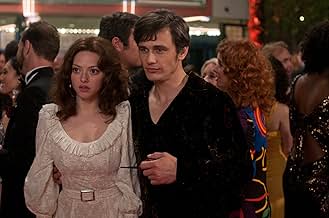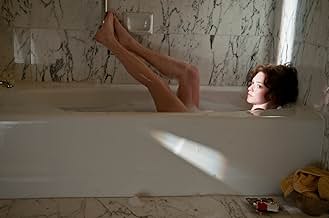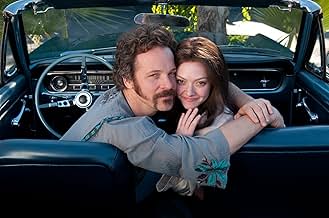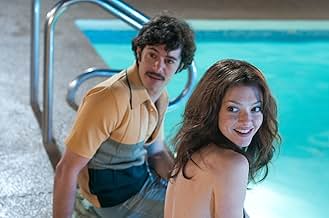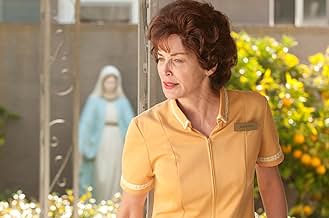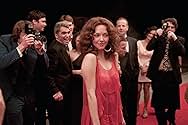La historia de Linda Lovelace, utilizada y abusada por la industria del porno a instancias de su represivo marido antes de tomar el control de su vida.La historia de Linda Lovelace, utilizada y abusada por la industria del porno a instancias de su represivo marido antes de tomar el control de su vida.La historia de Linda Lovelace, utilizada y abusada por la industria del porno a instancias de su represivo marido antes de tomar el control de su vida.
- Dirección
- Guionista
- Elenco
- Premios
- 1 premio ganado y 3 nominaciones en total
- Sammy Davis Jr.
- (as Ronald Pritchard)
- Dirección
- Guionista
- Todo el elenco y el equipo
- Producción, taquilla y más en IMDbPro
Opiniones destacadas
Poor and mediocre biopics either become blatantly overwhelmed by a life's complications, or ignore them altogether. Unfortunately, "Lovelace" chooses to ignore, and consequently misses greatness.
The woman who was born Linda Susan Boreman, and would later be better known by her stage name, Linda Lovelace, lived a very complicated, and devastatingly sad, life. This film centers on the real life Lovelace's claims of being used and abused by her first husband, Chuck Traynor, and being browbeaten into the pornography industry.
Lovelace's allegations of spousal abuse have been disputed by some, and supported by others who knew her personally, but that's beside the point. The film was right in basing its narrative solely on Lovelace's side of the story, not getting bogged down by antipathetic discrepancies. Still, there were crucial parts of her life the movie should not have left out.
For instance, "Lovelace" strongly implies that "Deep Throat" was Lovelace's first pornographic film (untrue) and her last (also untrue). It doesn't mention a stag film in which she engages in bestiality with a dog.
In one of her four books (yes, she wrote four books), she claimed that Traynor forced her to act in such movies, which would have made a good case in this movie for how controlling Traynor was. After all, having sex with a dog, especially on camera, is not an action in which most would engage willingly.
I could go on about relevant moments of the real Lovelace's life that this movie chose to ignore. However, the primary faults of "Lovelace" lie not in what they left out, but in a questionable storytelling structure where the filmmakers obviously tried to be too clever in their narrative.
Basically, the first half of the film chronicles a 21-year-old, naive Linda Boreman (Amanda Seyfried) who lives with her strict, Catholic parents (Robert Patrick and a shockingly deglamorized, unrecognizable Sharon Stone) in Florida. A charismatic, 27-year-old Chuck Traynor (Peter Sarsgaard) spots Linda at a rollerskating rink and begins dating her.
While Traynor claims to own a bar and restaurant, young Linda doesn't realize he dabbles in prostitution until after they are married, and she bails him out of jail. Eventually, Traynor coerces her into performing sexual acts on complete strangers for money before taking her to audition for pornographic movies.
From here, the film chronicles the making of the notorious "Deep Throat", the rise of Linda Lovelace, and does more than hint at the unexpected cultural impact the film creates.
Halfway through, the film makes the mistake of jumping ahead six years later (I guess circa 1980), and showing a visibly disheveled Linda taking a lie detector test administered by a publisher (Eric Roberts) in order to assess the validity of her marital abuse claims in her new autobiography, "Ordeal". The film then jumps back 8 or 9 years to show many of the same scenes over again, except adding footage at the end of each scene actually showing Traynor physically and sexually abusing Linda.
Why go back and show these scenes? The lie detector scene would have made a good narrative framework, especially since you see Amanda Seyfried look so shockingly worn down. This is not the same doe- eyed, blonde hottie from "Mamma Mia" (2008), or at least it doesn't look like her.
The point is, though, that going back and retreading all the scenes feels like a waste of time. Considering the film's running time of 93 minutes, there is no excuse for retread, especially considering Sarah Jessica Parker's well-publicized cameo as Gloria Steinem was cut out of the film altogether.
However, casting was the film's main strength, which I initially thought would be its weakness. I had my doubts about Seyfried portraying Lovelace, considering that Seyfried is exceptionally gorgeous, and the real Linda Lovelace was (Is there any way to say this nicely?) not even close. Listing actresses in this review who bear a stronger resemblance to the doomed porn starlet would probably be insulting to them.
While Seyfried donned a shaggy brunette hairstyle and freckles to deglamorize herself, she still looked a lot prettier than Lovelace on her best day. Scenes such as low-level mobster Butchie Periano (Bobby Cannavale) arguing that she is not attractive enough for the porno he is financing appear consequently more dubious.
Still, Seyfried did well with what she was given. Her best scenes include the lie-detection test, a surprisingly touching moment with an unexpectedly cordial publicity photographer (Wes Bentley), and her begging her emotionally cold mother for asylum from her abusive husband. Another scene where she is raped by five men at Traynor's behest shows little, but is still hard to watch.
While Peter Sarsgaard is effectively charismatic as Chuck Traynor, he wasn't convincing enough during the abuse scenes. Every time he threw Seyfried around, his face looked as though he would apologize to her right after the directors yelled "Cut!".
Sharon Stone, as Dorothy Boreman, had the movie's best performance, and not just because she is indistinguishable from her more glamorous roles. The scene where she does anything but console a visibly frightened Seyfried makes her eerily believable, and surprisingly multifaceted.
While the performances were well done, and "Lovelace" successfully shied away from exploitation, it suffered from fractured storytelling, awkward editing, and the vague epilogue implying that Lovelace's life only improved before her untimely death in 2002 in a car crash. If you watch the insightful documentary "Inside Deep Throat" (2005), or read Joe Bob Briggs' excellent, astute retrospective on her life (http://old.nationalreview.com/comment/comment-briggs042502.asp), you'll get a far more accurate, and grimmer, account of her life after pornography. It's sad, dismal, and, as "Lovelace" proves, a story Hollywood still does not want to tell.
The end of the film is what really redeems it. LOVELACE's best single aspect is its portrayal of the porno film industry and how the exploitation often goes much deeper than simply pressuring naive young ladies into being filmed doing things they loathe doing. There are, of course, many sides to any story: Some will like the slant LOVELACE takes; others inevitably won't. The makers of this film may have gone a bit too far in portraying Linda Boreman/Lovelace as a completely innocent girl-next-door who just happened to fall in with the wrong guy and his crowd, but I can see how that was hard to avoid.
Considering the subject matter, there is very little graphic sex/nudity, and it was obviously wise to avoid making an admonitory bio-drama about a porn star into a porno film in its own right.
The way this story was structured keeps it interesting and revelatory, and tonally the film is in accordance with her life. Things start off happy and there are lots of funny moments but soon enough things take a turn for the worse and that is where the true drama ensues.
Amanda Seyfried may not seem like the right choice for the role but she handles herself and the material with ease. She does a fabulous job evoking a wide range of emotions and brings her performance to a previously unseen level (at least, from what I've seen of hers). Peter Sarsgaard naturally exudes kindness and charm, we are seduced by it as she is, yet when the time calls for it he is rightly overpowering and terrifying.
Directors Rob Epstein and Jeffrey Friedman started off making documentaries that were both important and compelling. They made the switch to traditional narrative films with Howl which showcased their talent but Lovelace is further proof that they are multi-talented and continuing to grow in skill.
The film does leave out a few things, most likely for the sake of the narrative, Linda was forced to participate in several short pornography loops before she appeared in Deep Throat, including a bestiality film. She also made two movies after Deep Throat (including Deep Throat II).
The film has instant notoriety for its connection to Deep Throat and hopefully this will drive a bigger audience to it but it will likely gain some controversy as well for its association (in fact there was a small group protesting it at the premiere which is utterly ridiculous). I hope this film gets a large audience as marital abuse in its many forms is far too common a problem and needs to be brought to the forefront of discussion.
"Lovelace" tells of how young and pretty Linda Boreman, from a strict Catholic family, unlikely met and married a sleazy guy named Chuck Traynor.
First, she goes along with Chuck's wild idea to make a her a porn actress, exploiting a certain extraordinary talent of hers which would be the central theme of a little porn flick entitled "Deep Throat." She actually enjoyed the heady success of this stardom as Linda Lovelace, for a while at least.
In a sudden change of pace, the second half of the movie showed how Linda was abused by her husband, physically, mentally, sexually, financially. She quietly suffered this torture until she could not take it anymore and fights to get her old life back.
The acting of Ms. Seyfried was quite good, as she was able to convince us that she was Linda despite being cast against type. She will get us on her side before the film ends. People who watch this film expecting her to reveal more skin will be disappointed, as this Linda kept it pretty clean on screen. The image painted of Linda was actually very sympathetic as well, like it was all Chuck's fault. Ms. Seyfried played the perfect naive victim.
Peter Sarsgaard was effectively creepy as Chuck from the start. You really cannot understand how Linda would marry a guy like this. He could have portrayed being more charming in the beginning to convince us. But he looked like a creep even in that scene where he first met with Linda's parents (portrayed by Robert Patrick and a completely unrecognizable Sharon Stone.)
I think the main problem of the film was in its story telling. There was a very abrupt and stark transformation from happy Linda in Act 1 and sad Linda in Act 2. I think the director was trying to be stylistic about this, not telling these details linearly, instead going back and forth in time. I think this could have been told more effectively another way.
Linda's lifestory is a chain of confabulation and reinvention, all lives are, a matter of how we view our selves after the fact and deciding on the value. She wrote apparently no less than three autobiographies, with the third one being the 'real' dark story of what happened to her.
So the 'rise' part of the film sees a wholly innocent, fresh young girl being enticed - so pure and shy she won't even take her top off as she sunbathes with a friend in her own backyard! Silly. But that is how she chooses to frame herself reminiscing in the bathtub.
The 'fall' shows those gaps of horrible abuse that were omitted in that first narration. But that is what she chooses to recall as years later she takes a polygraph test on the behest of the publisher of her memoirs. And that is how Linda has chosen to present her story in her own book, herself pure and corrupted by a crazed husband.
This is not to say that she's making everything up, just as we know she isn't completely honest. Truth is usually somewhere in the middle. We see the alleged rape at gunpoint, yet there's no mention of her seedier films which she had denied doing until proof showed up.
So a film worthy of the subject would show two Lindas at odds, a softer understanding of the effort of trying to decide just who you are: the one who (re)writes her story, and the one who is genuinely caught up in it.
Here we simply get Linda the victim. In the end, a cleansed Linda goes on TV to warn against abuse and to promote 'finding yourself'. The film tries to show this reinvention of self and memory by being itself reinvented halfway through, yet in the end plies the same manipulation. The film 'settles' on her story being real, and presents it to us as the life of Linda Lovelace, why, because it comes with positive value we'd rather remember.
¿Sabías que…?
- TriviaIn an interview, Amanda Seyfried talked about why she had no issue with being naked in this and other films. "I don't know why I'm comfortable. Nudity: whatever! Sex: we all do it. There's a time and a place to be naked (laughs). There's no part in this movie that makes me think, 'Oh, wow, she's naked.' She's a porn star! We simulated some scenes but there's no graphic content in this movie, at all. I mean the graphic stuff is when he's raping me on my wedding night. You see my skirt go up over my head when I'm being gang raped, but it's like so perfectly done. 'Chloe' is so graphic. And this is not...(Peter Sarsgaard and I) are not shy about our private parts. We also weren't walking around with our genitals out; our bottom half genitals. That might have been a little strange for me. I don't really have any interest in people seeing my vagina. It's just a personal thing. I don't mind seeing other people's vaginas. I guess I'm just insecure in that way. Peter, same thing. He was always covered up in that way. I think it's just our mutual understanding of we needed to be naked a lot of points in the movie and it wasn't a big deal. It's like a costume. I don't know why I feel comfortable. To be honest, when I was younger, I was terrified of sex. I don't know what happened over the years. I now have an appreciation for it, for people who don't put so much heaviness on it. I also don't understand why it's censored in movies."
- ErroresIn a scene set in 1970, two characters discuss Contacto en Francia (1971), which was released in 1971.
- Citas
Linda: You know I spent exactly seventeen days in the pornography industry and somehow these seventeen days are suppose to define who I am for the rest of my life, but I hope that people can see me for who I really am. I mean Linda Lovelace was a fictitious character. My name is Linda Marchiano. I can finally be myself. I'm a mother and a wife and that is where I found my joy.
- Bandas sonorasI've Got to Use My Imagination
Written by Gerry Goffin and Barry Goldberg
Performed by Gladys Knight & The Pips
Copyright 1973 SCREEN GEMS-EMI MUSIC (BMI)
Courtesy of Buddah
by arrangements with Sony Music Entertainment
Selecciones populares
- How long is Lovelace?Con tecnología de Alexa
Detalles
- Fecha de lanzamiento
- País de origen
- Idioma
- También se conoce como
- Lovelace
- Locaciones de filmación
- Alex Theatre - 216 North Brand Boulevard, Glendale, California, Estados Unidos(Deep Throat private screening)
- Productoras
- Ver más créditos de la compañía en IMDbPro
Taquilla
- Presupuesto
- USD 10,000,000 (estimado)
- Total en EE. UU. y Canadá
- USD 356,582
- Fin de semana de estreno en EE. UU. y Canadá
- USD 184,536
- 11 ago 2013
- Total a nivel mundial
- USD 1,585,583
- Tiempo de ejecución1 hora 33 minutos
- Color
- Mezcla de sonido
- Relación de aspecto
- 1.85 : 1
Contribuir a esta página




